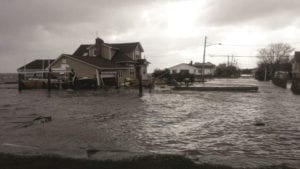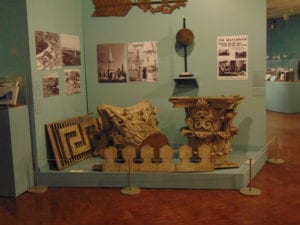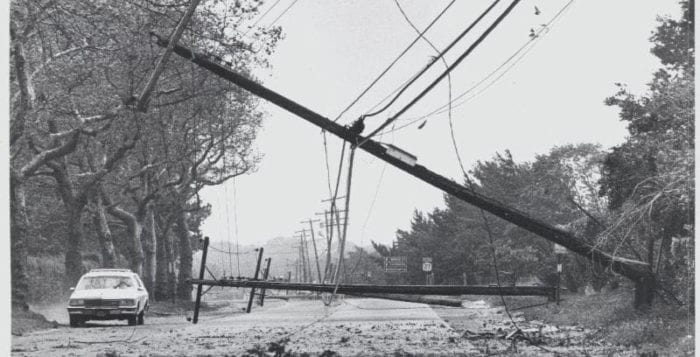Exhibit examines the many facets of dangerous storms
By Rita J. Egan
Five years after Hurricane Sandy hit the shores of Long Island, and as our country continues to recover from recent hurricanes, the new exhibit, In Harm’s Way, at The Long Island Museum in Stony Brook delves into the effect such storms can have on communities.

Nancy Solomon, executive director of Long Island Traditions, an organization dedicated to preserving local traditions and heritage, curated the exhibit. Through artifacts, hands-on activities, photographs and paintings dating back to the 1938 hurricane nicknamed “Long Island Express” and earlier, Solomon has created various vignettes where museum visitors can discover how residents and government agencies prepared and recovered from natural disasters through the decades.
“It’s really about how we have coped and prepared for storms both on a personal level and on a community level through history up to the present and looking forward,” Solomon said.
The curator said In Harm’s Way is an exhibit she’s been working on for a few years. Before Sandy hit Long Island, she was working on an exhibit about boaters and boatyards and talking to those who worked and lived along the coastlines.
“During Sandy I said to myself these people are going to have to cope with a lot of damage and to think forward to how they are going to prepare for this [in the future] since these storms are becoming more frequent,” she said. “And I thought of that while [Sandy] was happening. Chances are there are things they know that other people might benefit from, as well as things they don’t know that we might learn from that have happened over the last 100 years.”
Solomon, who has a M.A. degree in Folklore and American Studies from George Washington University and is an active member of the American Folklore Society, said the title of The Long Island Museum exhibit came about after talking to a fisherman who explained to her that those who work on the water have many ways of monitoring conditions to get out of harm’s way. “Ordinary people have tremendous knowledge, and we can learn from those things,” she said.
Solomon said one story she was told was about a boat captain who noticed the barometer went down one full point in an hour, signifying a tremendous drop in atmospheric pressure, during Hurricane Carol in 1954. While he used a ham radio to alert other captains to head back to shore, they didn’t heed his warning. While his crew made it back safely to Jones Inlet, the others didn’t. Solomon said the story had a big impact on her.
“That was my first major understanding that there are things that you have to pay attention to,” she said. “You have to pay attention to bird migration. You have to pay attention to fish migration because they are natural warning signs that fisherman are keenly aware of as well as people who live in places like Fire Island.”

Visitors to the exhibit will find it separated into three sections. The first — Looking Backwards — includes museum objects and items from personal collections from the 1938 Long Island Express to the 1991 Halloween nor’easter. Among the pieces are damaged items from 1938 including a clock that was mounted high on a garage wall that still bears the watermark from the Long Island Express hurricane.
A second section is dedicated to the hurricanes Irene, Lee and Sandy that occurred in 2011 and 2012 and their impact on Long Island and upstate New York. A featured artifact is a piece of the Long Beach boardwalk. Another piece that is a favorite of Solomon’s is a bay house, built by museum staff member Joseph Esser, where visitors can see what measures one can take to protect themselves when in harm’s way, including the use of bags filled with sand or clamshells.
The last section of the exhibit, Looking Forwards, focuses on solutions such as flood-proof homes and new technologies. There is also an interactive table where museum-goers can build their own home or community, taking into account safety measures for those who live along the coastline.
The museum’s curator Joshua Ruff compared the timely subject of battling storms to how generals and military planners talk about how the last war is still being fought as a new one is starting.
“I think that the exhibition really does a wonderful a job of looking at recent memory and looking at how memories have been guiding experiences for Long Islanders storm after storm after storm,” Ruff said.
Neil Watson, director of the museum, said he is pleased with the collaboration with Long Island Traditions and the exhibit that he said is informative and entertaining due to being visually stimulating. “For our museum to do a show that is focused on Long island and has a global overreach, I think is really terrific,” he said. “It’s what we do. It’s the mission of the museum to have an exhibit of this caliber, especially at this time given what’s happened recently, it’s become almost a timeless problem.”

Watson said the narrative is personal for everybody and the objects included in the exhibit are varied and effective. “They really give you a sense of place,” he said. “They put you in the moment as opposed to looking at a photograph of a house. So, I think in that way it’s a very ambitious installation of the exhibition, and it’s very effective. It’s pretty wonderful in that way.”
Solomon hopes that visitors will think about how waterfront and coastline communities are changing after viewing the exhibit. During her research, she said she learned a lot about the importance of high dunes and how hardening the shoreline may not be the best approach. “I hope they start asking questions of planners and our public agencies about the rationale for doing things and when there might be some better ways,” she said.
The Long Island Museum will host In Harm’s Way until Dec. 31. Special programs include the symposium “In Harm’s Way: Past, Present and Future” Oct. 28, a panel discussion “Learning from our Neighbors” Nov. 12 and the curator’s gallery tour Dec. 3. The museum is located at 1200 Route 25A in Stony Brook. For more information call 631-751-0066 or visit www.longislandmuseum.org.





